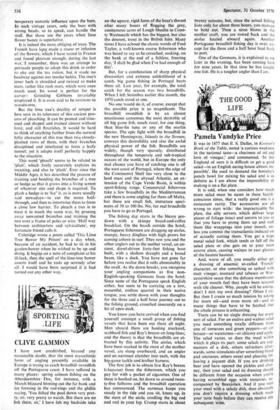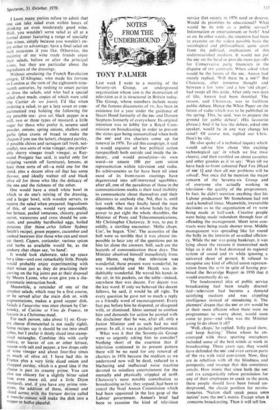THE GOOD LIFE Pamela Vandyke Price
It was in 1877 that E. S. Dallas, in Kettner's Book of the Table, noted 'a curious weakness in the national taste—a chariness of oil and love of vinegar,' and commented, 'In this England of ours it is difficult to get a good salad—in an English eating-house almost im- possible'. He used to demand the hostelry's punch bowl for mixing his salad and is as definite as I am about the impossibility of making it on a flat plate.
It is odd, when one considers how much more salad must be eaten in these health- conscious times, that a really good one is a restaurant rarity. The accessories are all wrong to start -with: the impracticable flat plate, the silly servers, which deliver large pieces of foliage intact and untorn to you so that you have to prong them up and stuff them like wrappings into your mouth, un- less you commit the transatlantic-induced sin of actually cutting them. You get a huge metal salad fork, which tends to fall off the salad plate or else gets on to your main course plate, causing waiters to cast glances of the hautest hauteur.
And, worst of all, you usually either get a dressing of anaemic so-called 'French' character, or else something so spiked with malt vinegar, mustard and tabasco or Wor- cestershire sauce that the delicate membranes of your mouth feel they have been scoured with tile cleaner. Why, people will be asking, don't I mix my own dressing? Often I try. But then I create so much tension by asking for more oil—and even more oil—and so many things that have to be fetched that the whole process is exhausting. There can be no single dressing for every sort of salad. For an endive and walnut salad you need something totally different from one of tomatoes and green peppers—or cos lettuce—or watercress—or chicory and apple. The salad varies, so does the meal within which it plays its part; some salads are aug- menters of a dish, others refreshers after- wards, some stimulants after something bland and unctuous, others sweet and pleasing fol- lowing a piquant dish. If you are drinking beer and have opened the pickles and chut- ney, then your salad and its dressing should be different from the occasion when you're having scrambled eggs with tomatoes, ac- companied by Beaujolais. And if you start your meal with a salady dish, then obviously you don't require a dressing which rasps your taste buds before they can receive any subsequent wine. I know many purists refuse to admit that one can take salad even within hours of drinking an even moderately good wine. Well, you wouldn't serve salad at all at a formal dinner featuring a range of specially fine wines, simply because you wouldn't en- joy either to advantage; have a final salad on such occasions if you like. Otherwise, the majority of my wine trade friends enjoy their salads, before or after the principal wines, but they are particular about the ingredients of the dressings. Without emulating the French Revolution emigre, D'Albignac, who made his fortune in London at the turn of the eighteenth-nine- teenth centuries, by rushing to smart parties to dress the salads, and who had a special salad chest made, copies of which were sold (the Carrier de ses fours), I'd like when ordering a salad, to get a lazy susan or com- partmented tray holding the following for my possible use: gros sel, black pepper in-a mill, two or three types of mustard, a little sugar for those who prefer it, sesame seed powder, onions, spring onions, shallots and garlic (plus crusts of bread to make the chapon if you use the latter), chopped parsley, if possible chives and tarragon (all fresh, nat- urally), two sorts of wine vinegar, one prefer- ably sherry vinegar (malt vinegar, as Ray- mond Postgate has said, is useful only for stripping varnish off furniture), lemons, at least three sorts of oil—a mild one for the timid, plus a decent olive oil that has some flavour, and ideally walnut oil and black olive oil for those who like the delicacy of the one and the richness of the other.
One would have a small white bowl in which to do one's mixing of the dressing, and a larger bowl, with wooden servers, to receive the salad when prepared. Ingredients of this, of course, would vary seasonally, but lettuce, peeled tomatoes, chicory, grated carrot, watercress and cress should be con- stant, and possibly hardboiled eggs, boiled potatoes (for those ,who follow Sydney Smith's recipe), green peppers, cucumber and cooked beetroot (for those who can and must eat them). Capers, coriander, various spices and herbs as available would be, as the cookery chat chaps say, 'to hand'.
It would look elaborate, take up space for a time—and cost remarkably little. People would probably enjoy experimenting with their mixes just as they do practising their carving on the big joints put at their disposal by Messrs Lyons, who even give you a dia- grammatic instruction book.
Meanwhile, a reminder of one of the simplest salads, which may be a first course, or be served after the main dish or, with augmentations, makes a good supper dish. Salade a l'angevine was once chosen by Cur- nonsky, of Cuisine et Vins de France, to feature in a Christmas meal.
For each person, take about If oz. Gruy- ere cheese (Emmenthal is not really right). Some recipes say it should be cut into small cubes, but I prefer it thinly sliced into stamp- sized rectangles. Combine this with curly endive, or leaves of cos or other lettuce, season with salt and pepper, a few drops only of wine vinegar and about four-five times as much of olive oil. I have had this in France plus a very little diced onion and chopped parsley, which is a good idea if the cheese is past its creamy prime. You can also use chicory for a slightly bitter salad (use even more oil, and a little Dijon mustard), and, if you have any prime tom- atoes, the addition of these, skinned and sliced across with the fretsaw device called a tranche-tomate will make the dish into a supper or buffet plateful.











































 Previous page
Previous page